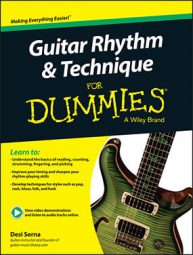When a guitarist rests the side of his hand across the bridge, and then comes onto the strings just enough to dampen the sound but not cut it off completely, it’s called palm muting. (Technically, it’s palm dampening, not muting, and you use the side of your hand, not the palm.) Typically, this technique is used on the lower‐pitched, wound strings, especially when playing power‐chord‐based songs. “My Best Friend’s Girl” by The Cars starts out with a palm‐muted guitar.
The introduction to “Hold On Loosely” by 38 Special is a good example of a guitar part that mixes sustained and palm‐muted notes. “All the Small Things” by Blink 182 opens with strings sustaining loudly, and then things quiet down in the verses through the use of palm muting. “Bombtrack” by Rage Against the Machine opens with a palm‐muted guitar riff and Metallica’s “For Whom the Bell Tolls” features a palm‐muted lead guitar figuration at 1:21.
The palm‐muting position is likely to be different from how you would normally position your hand while picking, so putting the two techniques together will take some reworking and practice. Playing just downstrokes while palm muting isn’t so hard, but fully alternating your pick can be a challenge. You may need to reposition your hand, hold the pick a little differently, and change what you do with your unused fingers.
In addition to using other palm‐muting exercises, you can play through this example that pedals on the open sixth string as you descend a chromatic line, similar to what you hear in Metallica’s “Master of Puppets.” You know that you’re supposed to palm mute because of the “P.M.” above the tab and the dotted line indicating how long to continue the dampening (in this case, the whole time).

To get the most out of this example, watch palm-muting and then follow these steps:
Play it with all downstrokes.
Play it using alternate picking.
Increase the tempo.
Play it on other strings.

